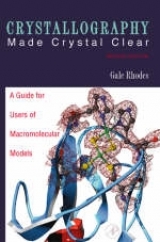
Crystallography Made Crystal Clear
A Guide for Users of Macromolecular Models
Seiten
1993
Academic Press Inc (Verlag)
978-0-12-587075-7 (ISBN)
Academic Press Inc (Verlag)
978-0-12-587075-7 (ISBN)
- Titel erscheint in neuer Auflage
- Artikel merken
Zu diesem Artikel existiert eine Nachauflage
Provides an overview of protein crystallography, examining the principles of how protein models are gleaned from X-ray analysis. The book explains the mathematics behind X-ray crystallography and provides accessible descriptions of principles built on simple foundations.
With the advent of recombinant DNA techniques, an increasing number of proteins are being expressed in sufficient quantities to be crystallized for X-ray diffraction analysis. At the same time, the efficient handling of data required to analyze diffraction data from macromolecules and graphics capabilities to display structures obtained from this analysis are also advancing. Consequently, huge numbers of new macromolecular models, especially protein models derived from X-ray crystallographic analysis, have appeared in recent years. The understanding of how crystallographers obtain these protein structures is essential for intelligent use of crystallographic models, whether that use is studying molecular action and interaction in cell structure, trying to unlock the secrets of protein folding, exploring the possibilities of engineering new protein functions, or interpreting results of chemical, kinetic, thermodynamic or spectroscopic experiments on proteins.
Most biochemistry or protein texts that address this issue, tend to contain a brief section or chapter on protein crystallography, and often these sections are too cursory and mystifying to provide readers with an incisive and comprehensive account of this specialized topic. At the other end of the spectrum are in-depth treatises that contain a thorough analysis of the theoretical and experimental details useful to practitioners, but often intimidating to non-crystallographers. This book is designed to meet a need for an X-ray analysis that is between brief textbook sections and complete treatment. It should provide non-crystallographers with an explanation of the principles of how protein models are gleaned from X-ray analysis. The understanding of these concepts should foster wise use of the models, including the recognition of the strengths and weaknesses of pictures and computer graphics. Since proteins comprise the majority of the mass of macromolecules in cells, and carry out most biologically important tasks, this book should interest most biologists.
Features of the book include an explanation of the mathematics behind X-ray crystallography and accessible descriptions of principles built on simple foundations.
With the advent of recombinant DNA techniques, an increasing number of proteins are being expressed in sufficient quantities to be crystallized for X-ray diffraction analysis. At the same time, the efficient handling of data required to analyze diffraction data from macromolecules and graphics capabilities to display structures obtained from this analysis are also advancing. Consequently, huge numbers of new macromolecular models, especially protein models derived from X-ray crystallographic analysis, have appeared in recent years. The understanding of how crystallographers obtain these protein structures is essential for intelligent use of crystallographic models, whether that use is studying molecular action and interaction in cell structure, trying to unlock the secrets of protein folding, exploring the possibilities of engineering new protein functions, or interpreting results of chemical, kinetic, thermodynamic or spectroscopic experiments on proteins.
Most biochemistry or protein texts that address this issue, tend to contain a brief section or chapter on protein crystallography, and often these sections are too cursory and mystifying to provide readers with an incisive and comprehensive account of this specialized topic. At the other end of the spectrum are in-depth treatises that contain a thorough analysis of the theoretical and experimental details useful to practitioners, but often intimidating to non-crystallographers. This book is designed to meet a need for an X-ray analysis that is between brief textbook sections and complete treatment. It should provide non-crystallographers with an explanation of the principles of how protein models are gleaned from X-ray analysis. The understanding of these concepts should foster wise use of the models, including the recognition of the strengths and weaknesses of pictures and computer graphics. Since proteins comprise the majority of the mass of macromolecules in cells, and carry out most biologically important tasks, this book should interest most biologists.
Features of the book include an explanation of the mathematics behind X-ray crystallography and accessible descriptions of principles built on simple foundations.
Models and molecules; an overview of protein crystallography; protein crystals; collecting diffraction data; from diffraction data to electron density; obtaining phases; obtaining and judging the molecular model; a user's guide to crystallographic models; tools for studying proteins.
| Zusatzinfo | tables, charts, photographs, colour illustrations, subject index |
|---|---|
| Verlagsort | San Diego |
| Sprache | englisch |
| Maße | 151 x 228 mm |
| Gewicht | 323 g |
| Themenwelt | Naturwissenschaften ► Biologie ► Biochemie |
| Naturwissenschaften ► Geowissenschaften ► Mineralogie / Paläontologie | |
| ISBN-10 | 0-12-587075-2 / 0125870752 |
| ISBN-13 | 978-0-12-587075-7 / 9780125870757 |
| Zustand | Neuware |
| Haben Sie eine Frage zum Produkt? |
Mehr entdecken
aus dem Bereich
aus dem Bereich



